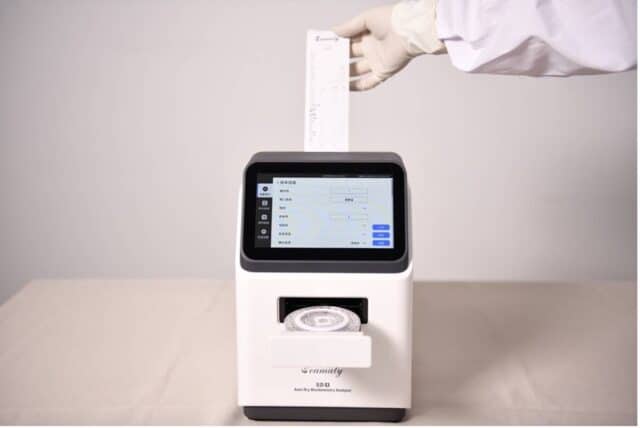Biochemical analyzers play a crucial role in any laboratory as they reveal valuable information that helps to efficiently and accurately diagnose a person. The information that can be gathered through this equipment includes:
- Liver function
- Kidney function
- Blood glucose level
- Lipid analysis
- And various other biochemical information needed to make a good diagnosis
Due to the information it provides and the importance it holds in a laboratory setting, the market is full of options ranging from simpler versions to much more complicated and sophisticated versions of biochemical analyzers. These biochemical analyzers can be classified into different categories to have a better understanding of their mode of work and functionality. These include:
Classification according to the degree of automation:
This type of analyzer needs some manual assistance when it comes to the analysis processes like holding, sample addition, colorimetric inhalation etc. Hence this type of analyzer is known as semi-automatic as many of the steps are done manually.
- Fully automatic biochemical analyzer
These analyzers are fully automatic from start to end recording the results. the entire process is done without any manual assistance and only the sample is put in by the lab assistant.
Classification according to the principle used in biochemical analyzer
- Continuous flow type
This is the very first and most conventional type of biochemical analyzer. The chemical reactions of samples and solutions are completed after the determination of the same constituent.
- Discrete
The reactions are completed in individual reaction compartments for each sample in this type of analyzer.
- Centrifugal
In this type of analyzer, each specimen is tested through the principle of centrifugal force in their tanks. This is the most accurate and efficient way to test as all the procedures like mixing, reaction and detection are occurring at the same time so the analytical efficiency is high.
- Dry film type
In these analyzers, the reagents used to react and detect the chemical composition are in form of filter paper or films and the specimen is added in form of drops for determining the results. These types of analyzers are useful due to their quick results and convenience as they are portable.

According to reagents and instrument systems
- Closed system
Both reagents and instruments are provided in form of a bundle and the manufacturer of the analyzer specifies the reagents that have to be used.
- Open system
Any reagent can be used in these types of analyzers and no specification is given.
Classification according to the size
- Small-sized instruments
These are single-channelled, simple, easy to operate models that can be put in small labs or rehabilitation centers or even ambulances.
- Medium-sized instruments
These are multi-channel and can measure more than one item at a time.
- Large-sized instruments
These are also multi-channelled with the capacity to analyze more than 10 items at once.
According to the biochemical analyzer reaction principle.
- Wet biochemical analyzer
This type of analyzer works by the Lambert-Beer law. The reaction carrier is in liquid form and the colored reaction products absorb the incident light. How much light was absorbed is then the measure of the concentration of the substance that has to be detected in the sample.
This is also known as solid-phase chemistry as it uses a dry reagent with a film that constitutes multiple layers. The sample is then added to the solid reagent and the reaction occurs that determines the different constituents of the specimen.

How to choose the best biochemical analyzer
Biochemical analyzers are used to identify different constituents present in biological specimens like urine or blood. This helps in the identification of the anomaly and the formation of a diagnosis.
While choosing an analyzer, keep in mind the degree of automation, amount of sample size the analyzer can hold and the accuracy and consistency of the results provided by the analyzer. All of these factors are extremely important when choosing an analyzer. Other factors that make a difference are size, model, budget and the specific features you might think are necessary for the type of particular analysis you want to run.
What are the technologies a biochemical analyzer use for measurement?
There are several analytical methods of measurement. They are divided into two categories:
- Optical techniques
– Colorimetry
– Photometry
- Electrochemical techniques
– Direct potentiometry
– Indirect potentiometry
How can you evaluate the performance of a biochemical analyzer?
Here are some important criteria that can help to evaluate the performance of the analyzer you are thinking to buy for your lab:
- Whether the analyzer is automatic or semi-automatic as fully automatic analyzers are better suited for large setups that have greater workload and need quick functioning, while semi-automatic models are best for small labs and medical offices that need to assess smaller volume samples.
- Cadence or the number of samples analyzed per hour can also be enhanced by the use of specific electrodes.
- The availability of random access mode offers a great deal of features that are useful in labs and hospitals that require speed and efficiency. With this feature, it is very convenient to put in random samples and still get continuous results in a short time with accuracy. This increases the efficacy of the whole process immensely.
What are some economical options for biochemical analyzers?
Here are the top four most efficient and economical options available in the market for biochemical analyzers:
- Mindray BA 88A Chemistry Analyzer, Semi-Auto
- Microlab ARX 199/199I Biochemistry Analyzer
- Microlab RX 50 Biochemistry Analyser
- Microlab RX 50v Biochemistry Machine
The ideal price range for a good, economical biochemical analyzer starts from somewhat to. Here are the top 10 recommendations under this price range that not only are very consistent and efficient in their results but fall in a bracket that is affordable for most of the people looking to buy this device.
- Erba Chem 5x Biochemistry Analyzer, Semi-Automatic
- Mindray BA 88A Chemistry Analyzer, Semi-Auto
- Erba Chem 7 Transasia Biochemistry Analyzer – Semi-Automatic
- Microlab ARX 199/199I Biochemistry Analyzer.
- Microlab RX 50v Biochemistry Machine.
- MS-484 Plus Biochemistry Analyser.
- Mindray BS-230 Biochemistry Analyzer, Full Auto
- RMS Analytica 705 Biochemistry Analyzer – Semi-Automatic
- Spectrum Spectralab-KT Genie Biochemistry Analyzer, Semi-Automatic
- Beacon Vchem Smart Biochemistry Analyzer, Semi-Auto
How costly an analyzer is related directly to the number of features and the type of brand you are going to choose. But a good biochemical analyzer that gives needed results and works effectively is also available in the market at a reasonable price range. All that is needed is a little research and study.
This is a sponsored post
Digital Health Buzz!
Digital Health Buzz! aims to be the destination of choice when it comes to what’s happening in the digital health world. We are not about news and views, but informative articles and thoughts to apply in your business.


